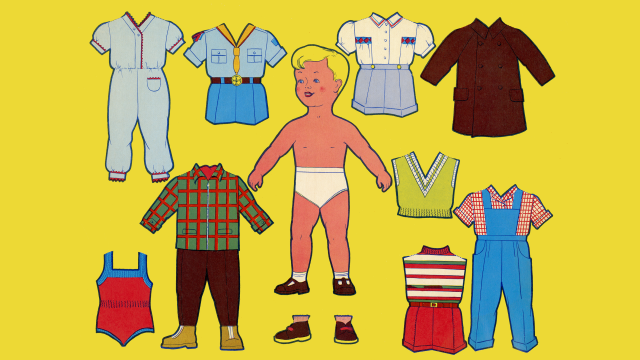Little kids are notoriously difficult to dress. Any parent who’s experienced a closet standoff with a naked child six minutes before they’re supposed to be at the bus stop can confirm. It could be that the kid is extremely picky or acting out of defiance, but what if it’s more than that? What if the issue is seriously impacting your family?
In one online forum, a mother complains her five-year-old throws a tantrum any time he has to wear footwear. Another parent is struggling with a child who refuses to wear socks because they “hurt”.
I’ve read stories about kids who explode into tears if there’s the tiniest bit of a tag left on a pair of pants or will only wear one very specific outfit day after day. Some children cannot function if a shirt is too tight, or too loose, or if there’s a button on it, or if the sleeves are cuffed.
For mums and dads who’ve tried everything, from timers to time outs, it can be maddening.
[referenced url=”https://www.lifehacker.com.au/2017/10/how-to-tell-the-difference-between-a-tantrum-and-a-sensory-meltdown/” thumb=”https://i.kinja-img.com/gawker-media/image/upload/t_ku-large/qxj6zph92u0owtlbhobj.jpg” title=”How To Tell The Difference Between A Tantrum And A Sensory Meltdown” excerpt=”As even the most mild-tempered kids will occasionally lose their crap in the lolly aisle or while leaving the playground, most parents have dealt with a tantrum or two. We’ve all developed our own personal strategies for dealing. Ignoring, giving timeouts or placating. But what if your kid’s freak-out isn’t a standard tantrum? What if it’s a sensory meltdown?”]
A mother named Joyce Slaton described in heartbreaking detail on The Longest Shortest Time parenting podcast what it was like when she tried to put a shirt on her then-toddler Violet while they were at the library.
“It was like she was being electrocuted,” she says. “She was convulsing at the end of my arm.”
The battle continued until the kid simply decided to stop wearing clothes all together. She went naked for an entire month, and during that time, they never left the house.
More Than Stubbornness
If a child says her clothing “hurts” or “stings” or “burns”, it might not be hyperbole. Instead, she could have sensory processing disorder (SPD).
Neuroscientist A. Jean Ayres, who was a pioneer in the field of sensory processing, explained that SPD is like a neurological “traffic jam” that prevents parts of the brain from receiving what it needs to interpret sensory information correctly. Kids with the disorder can’t “just deal with it”.
Researchers have been making the case that SPD is a distinct disorder independent of autism or ADHD, though it has still not yet been recognised as one. (It’s worth noting that SPD manifests in different ways — for instance, while one person might find certain clothing and other “tactile sensory input” to be unbearable, another might have no reaction to stimulation, even extreme hot or cold.)
One study showed it can affect at least one in 20 kids.
For parents, it’s important to understand that this isn’t about rebellion, says Susan G. Groner, author of Parenting: 101 Ways to Rock Your World. “For children with sensory issues, anything tactile can feel extremely uncomfortable,” she tells me. “If you don’t have this, it’s hard to understand.” Patience and empathy, she says, are key.
If you believe your child might be showing signs of sensory processing disorder, it’s best to have him evaluated by a trained professional. Treatment might include occupational therapy with a sensory integration approach.
For Slaton’s daughter Violet, after four months of therapy that included exercises such as popping bubbles with one finger and swinging on special swings, she was able to wear clothing.
Find Companies That Sell Sensory-Friendly Clothing
Along with treatment, parents are turning to sensory-friendly clothing to make kids with sensitivities more comfortable.
Socks and underwear can be a big issue for kids with sensory issues. SmartKnitKIDS makes socks, underwear and bralettes completely free of seams and any other type of “bumps and lumps”. Australians can grab them from It Makes Sense, an online shop which caters specifically to sensitive children.
Some parents have also found success with Boden, though their clothes aren’t specifically made with sensory-friendliness in mind.
Another pro-tip: With socks and underwear, some kids will find them tolerable if they wear them inside out.
Other Tips
Allow for natural consequences. For kids who you’re sure don’t have sensory issues, let them experience the natural consequences of not wearing certain clothing. If they can’t wear a shirt, they can’t go out and play with their friends. If they don’t wear socks, their shoes will be uncomfortable.
“Don’t make a big deal about it,” Groner says. “Don’t let it become a tug of war. Express the reason one wears socks. Then leave it up to your child for a bit. Chances are he will come around.”
Set up routines. It’s more likely that things will turn into a battle if kids must rush to get dressed. Start the process earlier. Have your child pick out their clothes the night before, and give them options so that they feel a sense of ownership.
At home, let them be (pantsless). Let the home be a sometimes-naked sanctuary, writes blogger MamaPlusOne, whose son Zack has clothing sensitivity issues.
“At home, we can be our truest versions of ourselves, and for Zack, that version of himself, that true essence of who he is, is pantsless. And that’s OK.”

Comments
2 responses to “What To Do When Your Kid Is Sensitive To Seams And Tags In Clothing ”
Although tags don’t bother me well not much does. Seams on pockets of polo shirts or the embroided logos irritate the hell out of my nipples.
Generic cesspool